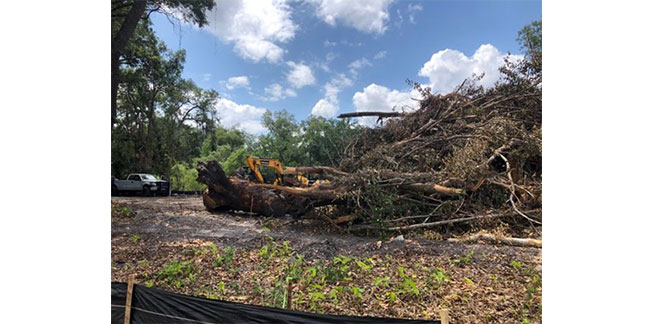
by Anne Mooney | Jun 5, 2021 | Tree Canopy, Zoning and Development
Howell Branch Chain Saw Massacre
by Anne Mooney / June 5, 2021
Once again, 1298 Howell Branch Road is in the news. There is no memory care facility this time, just four lots for single family homes. Sound simple? We’ve been here before.
Developer changes course in 2017
After the Villa Tuscany Memory Care Center failed in 2017 to receive approval, the developer, Villa Tuscany Holdings, LLC, revised its request and received City approval to divide the property into four single-family lots under the current R-3 zoning. The 3.77-acre property, of which only 2.09 acres is buildable because that is the portion above the Ordinary High Water elevation of approximately 66 feet, is located between two bodies of water. The larger to the south is Lake Temple; to the northeast is an unnamed sinkhole.
Four lake-front lots planned
Since all four are lakefront lots, new home construction must be reviewed and approved by the Planning & Zoning (P&Z) Board. The P&Z review focuses on tree preservation, storm water management, making sure plans are compatible with the grade of the lot and maintaining lake views. Each individual plan involves a negotiation with Urban Forestry Department, especially if a specimen tree is involved.
Developer begins work in May 2021
When the developer obtained a permit to begin work on the property in May, a 54-inch oak tree was to be preserved. In addition, a silt fence was erected to prevent clearing along a 50-foot margin from the lakefront to protect neighbors from noise and light pollution from Howell Branch Road.
54-inch oak takes the fall
On May 14, according to Parks and Recreation Director Jason Seeley, who oversees the City’s Urban Forestry Department, a subcontractor arrived with heavy equipment to clear the land. As the clearing began, the crews, unsupervised by the developer, proceeded to take down the silt fence, clear all the way to the lake front and cut down the large specimen oak.
Even after a Stop-Work order and a Code Violation were issued, City staff observed the contractors continuing to clear the land. The City contacted the developer directly, the Stop-Work order is still in place and work on the premises has halted.
Draft tree preservation ordinance planned
A draft Tree Preservation Ordinance has been approved by the Tree Preservation Board and is awaiting review by P&Z in July or August. Changes contemplated include a matrix that uses a range of species, conditions and sizes to generate a mitigation number. Mitigation is strengthened in some areas. For instance, the ordinance proposes separating residential from commercial and increases mitigation requirements for trees on residential property.
Most trees lost to residential development
We lose more trees to residential development than we do to commercial,” said Jason Seeley. “The biggest impact on trees over time is with residential development and building codes. When a small house is torn down to build a McMansion, we lose about 60 percent of available space for plantings on those residential lots. You just can’t plant your way out of that problem.”
Commissioner Sheila DeCiccio pointed out how important it is for alert residents to keep the City informed. “We have a very small Urban Forestry staff,” she said, “and they can’t be everywhere at once. In the case of the Howell Branch property, City staff was responding to neighbors who reported unpermitted activity on the site.”
In an email blast sent June 1, DeCiccio wrote about the proposed tree preservation ordinance. “This revision has several more steps to go through before it reaches a final form to be voted on by the City Commission,” she wrote. “The ultimate aim is to codify an easy-to-understand mitigation / compensation scheme reflective of the value that the citizens of Winter Park place on their trees.
“The tree canopy is an integral part of what makes Winter Park so special. The more we know, the better we can protect this precious resource.”
To comment or read comments from others, click here →

by Anne Mooney | May 26, 2021 | Zoning and Development
Open Letter to Mayor and Commissioners
We Need More Quiet Zones – Protect Progress Point
by Guest Columnist Charley Williams / May 26, 2021
 A friendly reminder. Just a few steps away from the Progress Point site sits Martin Luther King, Jr. Park, which has been stripped of well over 20 percent of its natural green space to make way for the Library-Events Center.
A friendly reminder. Just a few steps away from the Progress Point site sits Martin Luther King, Jr. Park, which has been stripped of well over 20 percent of its natural green space to make way for the Library-Events Center.
You have a chance to even the score and sooth sore feelings by using Progress Point to restore to our community some of that lost passive green space. Yet, it’s beginning to sound like you plan turn it into some sort of Church Street Station retail-a-palooza.
The entire length of Orange Ave is already a retail zone, and half of Progress Point is already slated to become parking.
How about using what’s left for a park bench with shade trees, bike racks, yoga mats, a drinking fountain, and a pond or fountain? But, please, a park bench without a discarded paper taco tray sitting on it, without a half-full soft drink can underneath it and without a nearby trash can overflowing with IPA cans. And without canned music spilling from a food court.
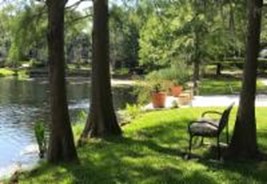 We do not need to be entertained 24/7. Parks, by definition, don’t need to be “activated.” What we need is the viewshed. What we need is some relative peace and quiet. We need to able to hear ourselves think. We would like to enjoy the natural light.
We do not need to be entertained 24/7. Parks, by definition, don’t need to be “activated.” What we need is the viewshed. What we need is some relative peace and quiet. We need to able to hear ourselves think. We would like to enjoy the natural light.
We have only one Progress Point. For the sake of the soul of our city and the souls who live here, honor it by keeping it green.
Please urge your designers to do better.
With appreciation for all you do.
To comment or read comments from others, click here →

by Anne Mooney | May 11, 2021 | News, Zoning and Development
$13 Million in Stimulus Funds Earmarked for Winter Park
by Anne Mooney / May 11, 2021
Winter Park stands to receive almost $13 million in federal stimulus funds earmarked through the American Rescue Plan (ARP), providing us a rare opportunity to rebuild from the pandemic and to shape future programs.
Tomorrow’s Commission discussion is one you may want to tune into, as it could directly affect many people and organizations in Winter Park.
Commission will decide where to spend the money
At its Wednesday, May 12, meeting, the Commission will undertake to prioritize the allocation of ARP dollars, which they anticipate will arrive in two payments. The first payment of $7,426,723 should arrive this month, May 2021; the second payment in the same amount should come in May 2022. The ARP requires all funds to be expended by the end of 2024.
Some dollars are restricted
Although guidance from the Feds is oblique (surprise!), City staff estimates about $3 million may be spent on any purpose the City decides, as these funds are intended to replace losses incurred as a result of the pandemic. A suggestion in a federal document reads, in part: “(1)(A) “. . . assistance to households, small businesses, and non-profits, or aid to impacted industries such as tourism, travel, and hospitality.”
The remaining $10 million will be subject to restrictions imposed by the legislation. Clearly allowed are transfers of funds to non-profits, economic development studies, water and sewer enhancements and internet improvements.
Other infrastructure dollars under discussion at the federal level
Less clear is whether the City can use these funds for transportation improvements. City staff is monitoring discussions at the federal level of a separate $2 trillion infrastructure bill, as that money could fund transportation improvements that are not eligible under the ARP.
Thoughts from the April 28 workshop
On April 28, the Commission held a workshop to discuss setting priorities for ARP funds. Funding that can only be spent on eligible categories fell into four broad categories: 1) recurring non-profit partners, excluding Dr. Phillips Performing Arts Center, 2) households and small businesses, 3) tourism, travel and hospitality, and 4) broadband.
Interesting among the categories was the discussion around “recurring non-profit partners.” First was the exclusion of the Dr. Phillips Performing Arts Center, which will still get its promised $100,000, but no extra money from the ARP pot of dollars.
Local organizations will receive extra ARP dollars
Commissioners discussed using the ARP funds to add 50 percent to current City funding levels for each of the following non-profits. For further detail and exact dollar amounts, click here: Local Organizations
Winter Park Public Library
Historical Association
United Arts
Polasek
Mead Garden
Winter Park Day Nursery
Blue Bamboo
Welbourne Day Nursery
Enzian Theater
Winter Park Playhouse
Depugh Nursing Home
Heritage Center (Crealde)
WPPL – just another non-profit?
The Winter Park Public Library, currently the recipient of the largest tranche of City dollars, could garner an additional $828,000 through the ARP – if it is treated the same as the other non-profits that receive City support. The question of whether or not to make the library a separate line item or to include it with the rest of the non-profits has yet to be answered.
“Apples and peaches,” says Weaver
“I would prefer the Commission discuss library funding from the ARP as a line item separate from the other non-profits,” said Commissioner Todd Weaver. “I don’t think we can compare the effect the pandemic had on the library with the effect it had on the other non-profits, which are dependent on sales or attendance at events. They are apples and peaches.”
Sullivan is of like mind.
“I am in favor of continuing the funding, which is approximately two-thirds of their budget,” said Commissioner Marty Sullivan. “However, it seems apparent that financial impact of COVID on the library would be less than on the other non-profits, because they already rely primarily on the City for their funding, whereas the others do not.”
Commissioner Carolyn Cooper said she thought it might be a good idea to consult one of the City Advisory Boards as to the appropriate allocation of funds among these groups.
Tune in tomorrow to find out.
To comment or read comments from others, click here →
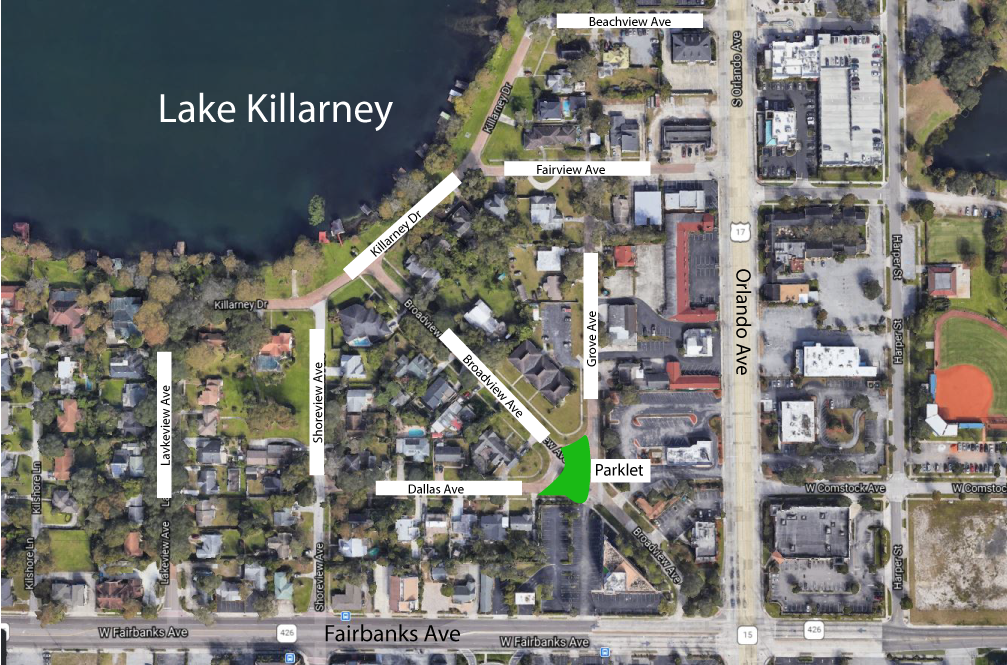
by Anne Mooney | Mar 30, 2021 | News, Zoning and Development
Killarney Estates – No Longer the ‘Forgotten Triangle’
Can the City Reunite the Neighborhood?
In late January, plans to build the Henderson Hotel in the triangle bordered by 17-92, Fairbanks Avenue and Lake Killarney, known as Killarney Estates, ran headlong up against Comprehensive Plan Policy 1-J-9, which reads, “Protect Single-Family Residential Use in the Killarney Neighborhood from Non-Residential Land Use Encroachment. The City shall preserve and protect the single-family residential land use within the Killarney neighborhood from commercial and office encroachment . . . .”
Just before midnight on January 27 — before the Commission could vote on Commissioner Marty Sullivan’s motion to deny – attorney for developer Adam Wonus withdrew the application to build the hotel. It was Game Over.
Killarney Neighborhood’s cut-through traffic
Despite the outcome for the Henderson, Adam Wonus’s two-year effort to win approval for his project produced some positive results for this neglected corner of Winter Park by shining a light on serious traffic problems and general infrastructure neglect by the City. For years, Killarney residents had been plagued by cut-through traffic trying to avoid the major intersection of 17-92 and Fairbanks Avenue, and the development of way-finding apps has only made matters worse as Waze and others direct drivers going from 17-92 to Fairbanks (or the reverse) through the back streets of the neighborhood.
City Planners to the rescue
When Adam Wonus began meeting with the Lake Killarney neighbors about his proposed hotel, they described their traffic woes and Wonus alerted City Planners to their need for help. Commissioners and City staff met with the neighbors and decided to field test a traffic barrier on the southern leg of the intersection of Killarney Dr. and Fairview Ave. The City also created a permanent physical separation of Grove Ave. from Dallas Ave. and Broadview Ave. Adam Wonus even paid for the planter bollards that formed the barrier at Killarney Drive and Fairview Ave.
The traffic calming measures worked, cut-through traffic has slowed to a trickle and most Killarney neighbors are living happily ever after.
Unintended Consequences – A Neighborhood Divided
The demise of the Henderson project, however, has left what would have been the commercial hotel property separated from the rest of the neighborhood. The successful measures to tame cut-through traffic in the residential area southwest of Fairview now separate that part of the neighborhood from the portion north and east of Fairview.
The northeast part of the neighborhood is a mix of residential, commercial and office, and part of it fronts on 17-92, but there are still residential lakefront parcels in that area which most of the Killarney neighbors and the all of the City Commission wish to protect from commercial development.
How to put the neighborhood back together?
At a special Commission meeting February 11, 2021, the Commission directed staff to come up with additional options to protect the residential lakefront property and to reintegrate those properties into the existing transportation network. City staff also has initiated negotiations with mapping companies to eliminate cut-through routes through the Killarney neighborhood.
Decisions on traffic solutions must be based on future land use
At the March 24 Commission meeting, Planning Department staff presented 12 possible solutions to the remaining traffic problems.
Commissioner Carolyn Cooper quickly pointed out how the cart may have gotten ahead of the horse. “There are very different possible traffic solutions, depending on what the land use is,” she said. “Before we talk about zoning, let’s talk about what future land use really makes sense on these five or six parcels. The traffic solution must be based on a resolution of future land use by this Commission.”
Commission agrees to future workshop to discuss future land use
Of the possible solutions to the traffic problems, the City’s first option describes measures that either are already in place or well into the planning stages. It includes the planter bollard barrier at Fairview and Killarney Dr., and a small park area that would cut off the connection between Broadview, Dallas and Grove Avenues. This area already has been cordoned off with temporary barriers and cones. The only thing missing was a funding source. To build the “parklet,” as it is called, the City had to find $165,000 in additional funds.
CRA or Parks Acquisition Fund?
Since the intersection of Broadview, Dallas and Grove falls within the CRA, money could come from CRA, or because it’s a ‘parklet,’ the money could come from the Parks Acquisition Fund.
Commissioner Sheila DeCiccio made a motion to move forward with this option, to leave the bollards as they are, build the ‘parklet’ with $165,000 from the Parks Acquisition Fund and to hold a workshop to discuss future land use and a more permanent traffic solution based on the future land use. Commissioner Todd Weaver seconded. Weaver amended the motion to add approximately $3,600 to reimburse Adam Wonus for the cost of the bollards, with a second from Commissioner Marty Sullivan.
The main motion, as amended, passed on a 5-0 vote.
To comment or read comments from others, click here →

by Anne Mooney | Feb 2, 2021 | News, Opinion, Zoning and Development
In Answer to ‘A Letter to Winter Park Residents’
Editor's Note: Articles written by citizens reflect their own opinions and not the views of the Winter Park Voice.
Guest Columnist Peter Gottfried / February 2, 2021
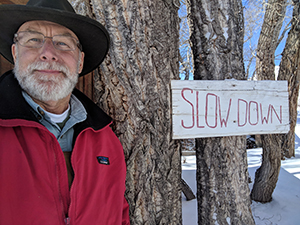 Peter Weldon, a former Commissioner, recently wrote to “fellow Winter Park Residents” outlining his opposition to Phil Anderson’s candidacy for Mayor. Mr. Weldon, as many of you know, ran for City Commission three times. He was elected to one term 2016-2019. He lost in 2008 to Phil Anderson, and again in 2019 to Todd Weaver.
Peter Weldon, a former Commissioner, recently wrote to “fellow Winter Park Residents” outlining his opposition to Phil Anderson’s candidacy for Mayor. Mr. Weldon, as many of you know, ran for City Commission three times. He was elected to one term 2016-2019. He lost in 2008 to Phil Anderson, and again in 2019 to Todd Weaver.
Questionable arguments
In his recent letter, Mr. Weldon seeks to lay what he sees as the current Commission’s shortcomings at Phil Anderson’s door and to question Anderson’s character in the process. These questionable arguments deserve closer examination.
First, Weldon claims, “the actions of Commission members Weaver, Sullivan and DeCiccio bring Phil Anderson’s judgment into question.” If you think about that even for a minute, you’ll realize it’s a bit of a stretch.
Weldon’s assertions
Mr. Weldon wants you to believe that the current Commission . . .
- “Voted to increase the property tax rate 11.5%.”
FALSE: The tax rate (millage) did not change in 2021 and has not changed for 13 years.
- “Voted to “rescind” the Orange Avenue Overlay, changing our Comprehensive Plan in violation of our laws, resulting in legal action against the city (case number: 2020-CA-004388-O).ci”
MISLEADING: Absolutely no laws were violated. In fact, the judge recently granted the City’s motion to dismiss the Orange Avenue Overlay developers’ lawsuits against the City.
- “Spent several hundred thousand dollars for consultants for additional Orange Avenue traffic studies and to plan a design they (the Commission) like for the City owned Progress Point property on Orange Avenue. Their plan has no professional planning input, and they offer no strategic justification for it, nor clarify who they expect will pay for implementation (you?).”
MISLEADING: This statement is very misleading. Professional planning input has been provided at every step through contracts to professional architectural and engineering firms; in addition, many professionals have donated their time, free of cost, to advise the Commissioners during their many work sessions.
- “Commissioners Sullivan and DeCiccio recently voted to spend $2,800,000 from our emergency reserves outside the annual budget process with no planning and they tried to hide the expense by “borrowing” the money from our water and sewer emergency reserves.”
MISLEADING: This is again misleading. First, there was no attempt to ‘hide’ the expense, it was openly discussed and had the support of Mayor Leary. The funds the current commission plans to borrow will be replenished with funds made available from soon-to-be retired bonds for the Public Safety Building. There is some irony in the fact that Weldon supports a mayoral candidate who gave $1million of taxpayer money to the Dr. Phillips Center for the Arts as a “donation.” No other City in central Florida, except the center’s home city of Orlando, gave a penny.
- “Insisted on a “back yard chicken” ordinance. Do you want chickens in your neighborhood?”
TRUE: The chicken ordinance was limited to 25 permits on a limited two-year trial basis. So far, two permits have been granted, a third application is still pending, but as yet, we still have no chickens. As a self-proclaimed property rights guy, Mr. Weldon might have been expected to support such a measure. Backyard chickens are already approved in Orange County, Maitland and Orlando, and all three jurisdictions report no problems so far.
- “Voted to diminish our city’s sovereignty by committing Winter Park’s support to an unaccountable state mandated planning agency.”
FALSE: This regional planning initiative does not in any way affect our sovereignty. It is a Memorandum of Understanding with the East Central Florida Regional Planning Council. It requires no City funding, only cooperative planning efforts. Considering we have approximately 1,000 new residents coming into central Florida every week, why wouldn’t it be prudent to ask for regional planning assistance, especially if it is free? Wouldn’t we want to be a part of the regional planning that directly affects our traffic, roads and water resources?
- “They are now considering spending millions of dollars to buy land on Fairbanks to ‘improve traffic’ without having any idea whether traffic will improve or not.”
MISLEADING: This from the same person who voted to sell City-owned land that was adjacent not only to Fairbanks Avenue but also to Martin Luther King Park. We all know Fairbanks traffic needs improvement, and professional traffic engineering firms are actively assisting the current Commission in their planning efforts.
To comment or read comments from others, click here →
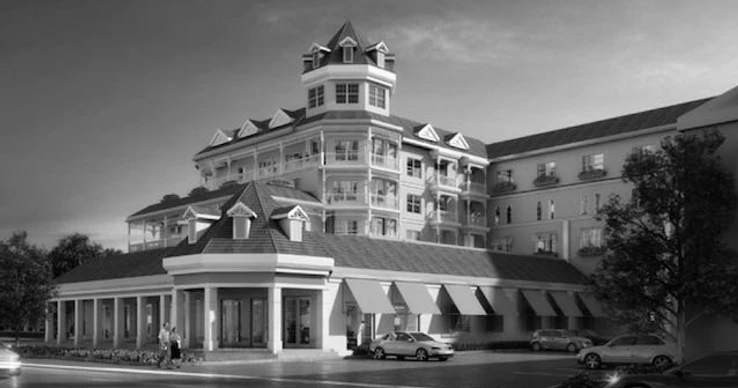
by Anne Mooney | Jan 29, 2021 | Zoning and Development
No Henderson Hotel for Winter Park
by Anne Mooney / January 29, 2020
Once again, the City Commission meeting went on longer than a bad dream, finally limping to a halt just before midnight January 27. With routine business addressed early and dispatched quickly, most of the meeting revolved around the First Reading of the Henderson Hotel requests for Conditional Use and changes to the Comprehensive Plan and Zoning Codes.
The developer, Adam Wonus of Winter Park Historic Hotels Group, was also requesting an ordinance to vacate portions of Killarney Drive and Fairview Avenue so that visitors to the hotel — be they hotel guests or Winter Park residents — would have unfettered access from the hotel to the lakefront. In return, the developer planned to provide landscaping and cleanup for the lakefront plus just under an acre of open green space and parkland.
Citizens support ‘City asset’
Wonus spent the past few years meeting people, going door-to-door in the Killarney neighborhood in an attempt to devise a commercially viable hotel project that would be an asset to the City while, at the same time being compatible with the neighborhood. As a result, a preponderance of commenters at Wednesday night’s Commission meeting were strongly in support of the Henderson project. They said not only would the project be good for the City, it would also greatly enhance the section of 17-92 between Beachview and Fairview Avenues south of the Trader Joe’s shopping center.
Neighbors oppose commercial development
On the other side of the question was a well-organized group of Lake Killarney neighbors who employed a cadre of experts — lawyers and engineers — to oppose approval of the project. They were concerned about the impact such a large project would have on the health of the lake, the light and noise pollution generated by large events at the hotel and the encroachment of commercial activity in their residential neighborhood.
Commission Divided
As the discussion moved from public comment to discussion among the Commissioners, it became clear that the Commission was divided among its members, and that several Commissioners were ambivalent in their own thinking.
Developer offers plan changes
In the midst of the Commission discussion, attorney for the developer Becky Wilson offered a list of changes to the project that including eliminating the ballroom and the subterranean parking garage, going from five to four stories and eliminating the surface parking on the park that was planned adjacent to the hotel.
To accept this offer, the Commission would have had either to change the proposed development agreement on the fly or vote on it as presented and trust that it would be changed later. They balked.
Commissioners want to postpone
Mayor Steve Leary moved to accept the application as presented, and proposed to send the developer and the staff back to the drawing board to come up with revised plans for the Second Reading. When Leary’s motion failed to get a second, Commissioners Sheila DeCiccio and Carolyn Cooper attempted to get the applicant to agree to table the issue until the plans could be revised. “I cannot, in all conscience, vote on an ordinance that does not accurately reflect the project,” said DeCiccio.
Attorney Wilson responded that if the project were tabled, they would withdraw the application.
Sullivan and Weaver opposed
Commissioners Marty Sullivan and Todd Weaver gave extended explanations for their intent to withhold support. “This is a grand project,” said Sullivan, “but it’s in the wrong place,”
Weaver stated his refusal to go against the measure in the City’s Comprehensive Plan that says the City ‘shall protect the residential character of the Killarney neighborhood,’ and said he opposed rezoning residential R1A properties to C3 commercial.
When Commissioner Marty Sullivan moved to deny the Henderson application, attorney Becky Wilson stepped to the microphone and stated, “Mayor, we withdraw our application.” No vote was taken, giving the applicant the opportunity to resubmit the application at any time.
Editor’s note: This sentence has been corrected to reflect the Commission motion to deny.
No vote was taken.
One word was used by people on both sides of the issue to describe what happened: Sad.
Commissioner Carolyn Cooper said, “I’m so sad that we couldn’t work something out, because we had a really good development team with strong financial backing. Adam’s job is to dream big. Our job is to uphold the Comp Plan.”
“The Comp Plan is our value system,” said Cooper, “and it says we must protect our single-family neighborhoods. Actually, that neighborhood is a mixture of residential, commercial and office. But if we are going to allow commercial development in an area like that, I want to be damned sure it’s compatible with the residential neighborhood.”
Killarney resident Lisa Waddington expressed similar sentiments. “I feel sad about the whole thing,” she said. “Millions of dollars and thousands of hours have been expended. While this is not a ‘victory,’ per se, I am grateful that the Commission has upheld the residential character of our neighborhood, giving us the chance to reach for our full potential. We want our neighborhood to be known as an urban, boho, cool corner of the city – hiding in plain sight. Hillstone matches the scale and character of our neighborhood. It’s smaller and low-key. Unfortunately, the Henderson did not.”
Waddington described how the developer had helped the neighborhood in their dealings with the City. “Adam listened to the residents, and he had influence. He helped us get the City to fix the bricked streets and put in cut-through barriers. And Commissioner Sullivan is clear that he wants to work with us in the future to address storm water drainage and lake cleanup.”
Adam Wonus said, “I don’t know – it was really sad. We had a lot of support, and we met so many nice people. Everything we did was to provide benefits to everyone, but a small group of people was able to block an investment in the City. The Henderson would have been an amenity – one that was on the tax rolls. The cost to redraft the plans is about $125,000. That was my money – real money, out my pocket, and I just couldn’t afford to do it any more.”
Asked if he thought he might be able to bring the project back at a later date, he said, “I think not.”
To comment or read comments from others, click here →

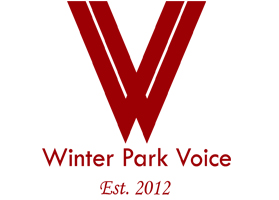








Recent Comments